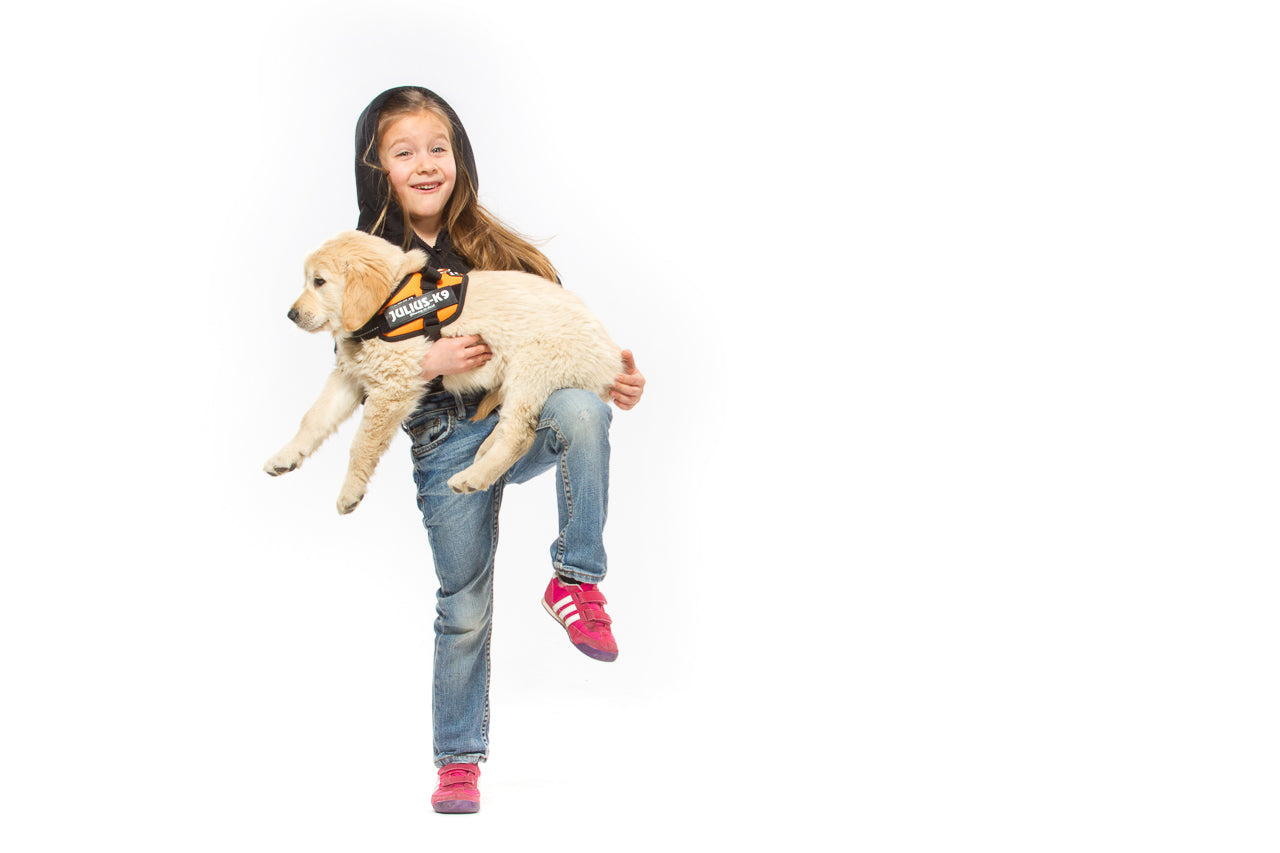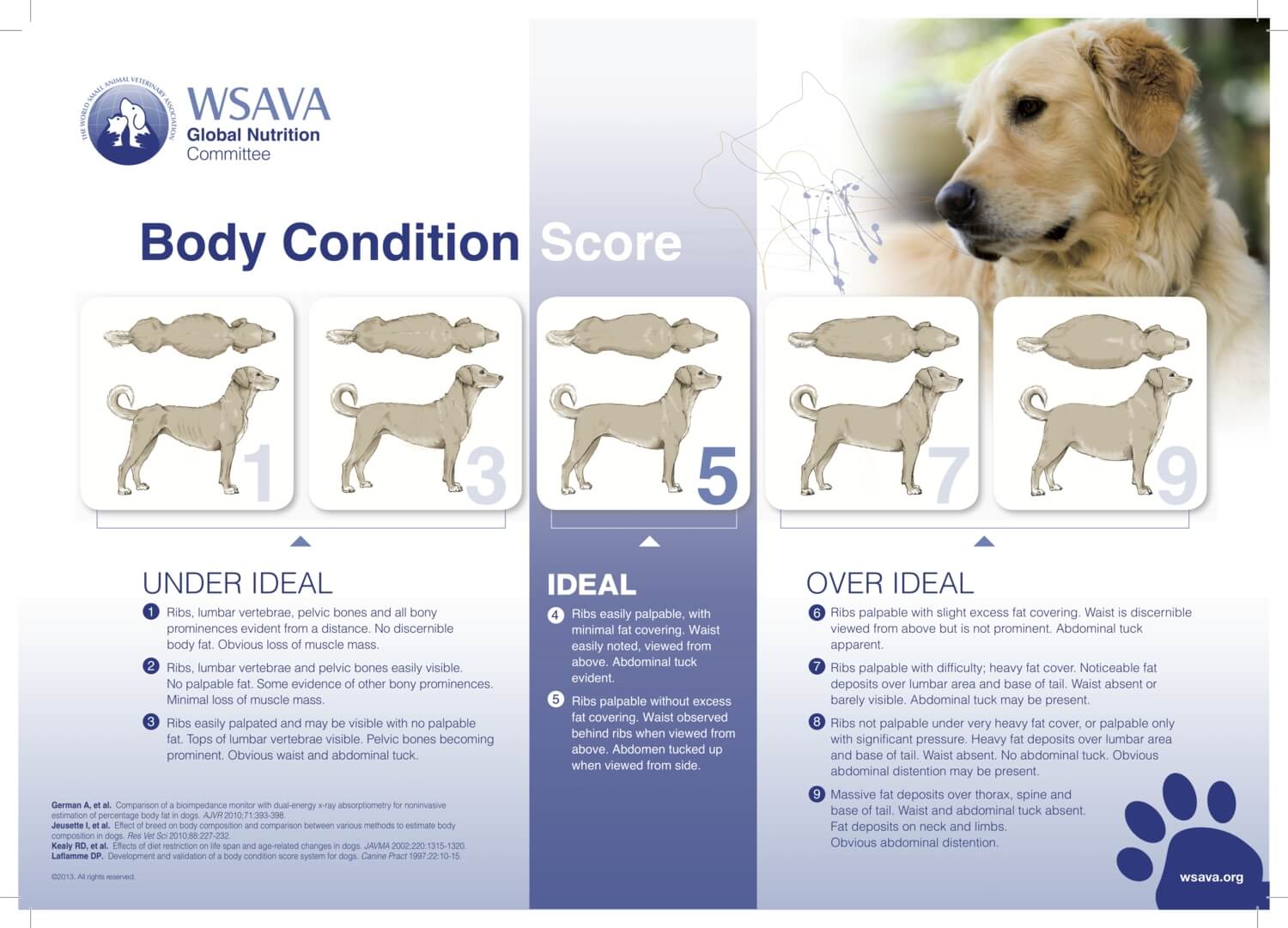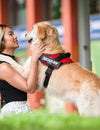
If your dog is overweight or obese it can hinder their mobility, increase the likelihood of them developing diseases (including diabetes), and can shorten their lifetime. By making sure your pet eats appropriate portions, has a balanced diet, and gets enough exercise, you can help them have a healthy and happy life.
But how can you tell if your dog is already overweight or how can you monitor your dog’s weight? And if your dog is already obese, where do you begin in reducing their weight?
Below are a few pointers to where to start.
Is My Dog Overweight?
You can often tell if your dog is overweight by sight. WSAVA, the global veterinary community, provide a Body Conditioning Score chart for dogs.

The score provides four levels (6 to 9) for Over Ideal dog body types, with checks any owner can do to see if their dog fits into any of these categories:
- Ribs palpable with slight excess fat covering. Waist is discernible viewed from above but is not prominent. Abdominal tuck apparent.
- Ribs palpable with difficulty; heavy fat cover. Noticeable fat deposits over lumbar area and base of tail. Waist absent or barely visible. Abdominal tuck may be present.
- Ribs not palpable under very heavy fat cover, or palpable only with significant pressure. Heavy fat deposits over lumbar area and base tail. Waist absent. No abdominal tuck. Obvious abdominal distension may be present.
- Massive fat deposits over thorax, spine and base of tail. Waist and abdominal tuck absent. Obvious abdominal distension.
These are great sight checks to do but if you are able to also weigh your dog you will be able to get a complete assessment.
Weighing Your Dog At Home
You can do this at home with regular bathroom scales. First weigh yourself, then weigh yourself while holding your dog, then subtract your weight from this number.
Breed Weight Guide
vets-now.com provide an extensive list of dog breeds and their ideal adult male and female weights. Please keep in mind that these are rough guides.
If your dog does fit into one of the four Over Ideal categories or is over the recommend breed weight, then it’s likely to be considered overweight. However, you should always check with a professional first, who will be able to give a thorough medical check-up.
How To Reduce Your Dog’s Weight
Any weight loss program can seem daunting at first, but simple changes to your dog’s diet and a daily exercise routine are all that’s needed.
Food Potions & Regular Feeding Times
How much food you should be feeding your dog greatly depends on the age, breed, and sex of the dog. It also depends on the nutritional value of the dog food.
Weighing Out Food: You should use kitchen scales to weigh out potions. The label on the pet food should tell the food measurements suitable for the dog’s weight. Some also have a daily feeding guide you can follow.
If your pet food doesn’t advise portion sizes on the label, then Dog Food Advisor has a handy calculator here to give you a rough idea of how much food to serve.
Scheduled Feeds: You should introduce strict feeding times. Giving your dog treats or allowing them to graze throughout the day means you won’t be able to track their food intake.
Feeding twice a day, once in the morning and once in the evening, is advisable. This helps keep their energy levels up and regulate their glucose levels.
A Balanced Diet
Feeding your dog the right food is essential. The most important advice is to buy commercially available food from trusted sources. Good quality brands will offer good nutritional value.
Making food for your dog at home can lead them to not getting the right balance of nutrition, and it can be difficult to judge potion sizes.
Longer & More Frequent Walks
It can be tempting to want to immediately introduce a hard training regime to whip your dog into shape. But a slow introduction of low impact exercise, like longer and more frequent daily walks, is a more effective and safer tactic.
This is because obese dogs can quickly become overheated and develop heat stroke - which can be fatal in dogs. Obese dogs are also at a higher risk of joint injures and soft tissue damage. Fatter dogs should avoid high insanity exercise like full sprinting and jumping after long periods of inactivity.
K9 Weight Challenge outline 13 Steps to getting your dog on a sustainable exercise routine, including a slow and steady approach to increasing walks:
“Aim for 2 x 10 minute lead walks a day. Over the course of 3-6 months aim to increase to 2 x 30 minute walks daily.”
Maintaining A Healthy Weight
One your dog is at a healthy weight it can be easy to slip back into bad habits. It’s important to always properly exercise your dog and feed them the suitable amount of food throughout their life.
It’s common among pet owners to make the mistake of thinking that the more food you give them the more they’ll love you. Dogs will overeat if you let them. If offer them table scraps and snacks they are unlikely to ignore you.
There is nothing wrong with the odd treat here and there, especially if you are training them and treats provide a reward, but you should always monitor how many treats you give.
Regular check-ups will give you a clear understand of your dog’s health. A vet will be able to tell you if your dog is putting on weight, is developing weight based disease or health concerns, and can see if they are getting a well balanced diet by basic checks to teeth, gums, as well as their coat.





